Physical Address
304 North Cardinal St.
Dorchester Center, MA 02124
Physical Address
304 North Cardinal St.
Dorchester Center, MA 02124

Dreaming of a cozy, lush oasis—no yard required? These small-space home garden ideas turn balconies, patios, and porches into green retreats. From a vertical garden on a chic vertical trellis to container gardening with self-watering planters, we’re sharing smart tips for every small garden. Try a modular raised garden bed, start an herb garden kit by the kitchen door, and layer vines, blooms, and textures for instant charm. Finish your backyard makeover with warm outdoor string lights and watch your mini sanctuary glow. Ready to grow big style in tiny spaces?
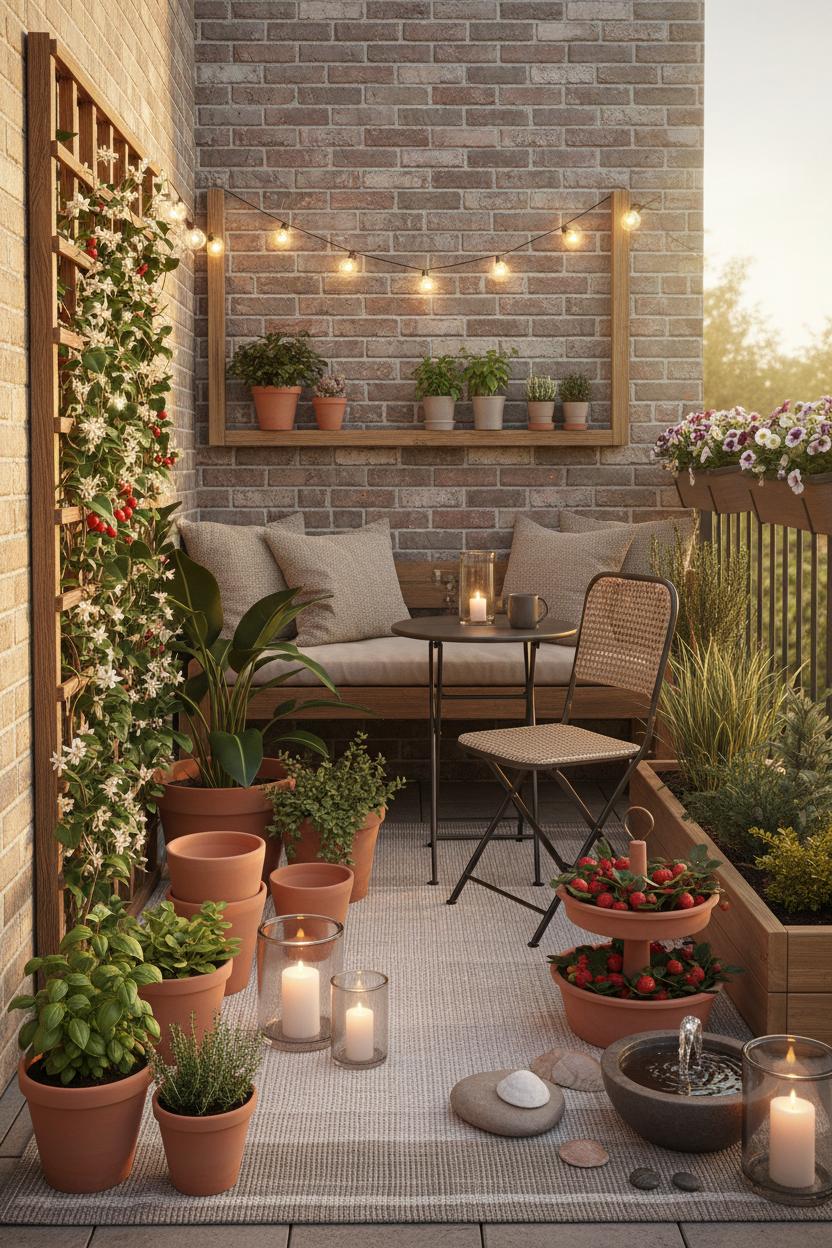
Think of this little tour as a mood board you can step into: start by carving out one irresistible nook and let it spill over. For a small garden, the magic is in layers—soft cushions on a compact bench, a cluster of pots in varied heights, and a vertical garden that pulls the eye up and makes the space feel taller. Try container gardening in tonal neutrals for calm, then tuck in a few glossy leaves or trailing vines for drama. A slim vertical trellis turns a blank wall into a leafy feature, perfect for jasmine, peas, or mini cucumbers. If you have even a sliver of soil, a raised garden bed gives structure and tidy edges; if not, balcony rail planters and self-watering planters keep everything lush with less fuss. These home garden ideas work like styling tricks: repeat a color, vary textures, and let one plant be the star while the rest play backup. Add a petite bistro set, a woven outdoor rug, and a couple of pretty stones or shells, and suddenly your everyday corner looks curated, not crowded.
Now layer in glow and scent for the cozy factor. Drape outdoor string lights overhead so the whole space feels like golden hour on demand, and scatter candles in hurricane jars for twinkle at ground level. An herb garden kit on the windowsill or by the door gives you instant fragrance and fresh snips for dinner, while a compact water feature or bowl fountain adds a soothing hush. Keep a few edibles close—cherry tomatoes climbing the vertical trellis, basil and thyme thriving in self-watering planters, and strawberries spilling from a terracotta stack. For a quick backyard makeover, edit ruthlessly, group plants by sunlight needs, and use matching containers to pull everything together. When the season shifts, swap in hardy evergreens and grasses so the structure stays while the accents change. With these small, high-impact touches, your small garden becomes a cozy, lush escape that you’ll want to step into every time you pass the door.
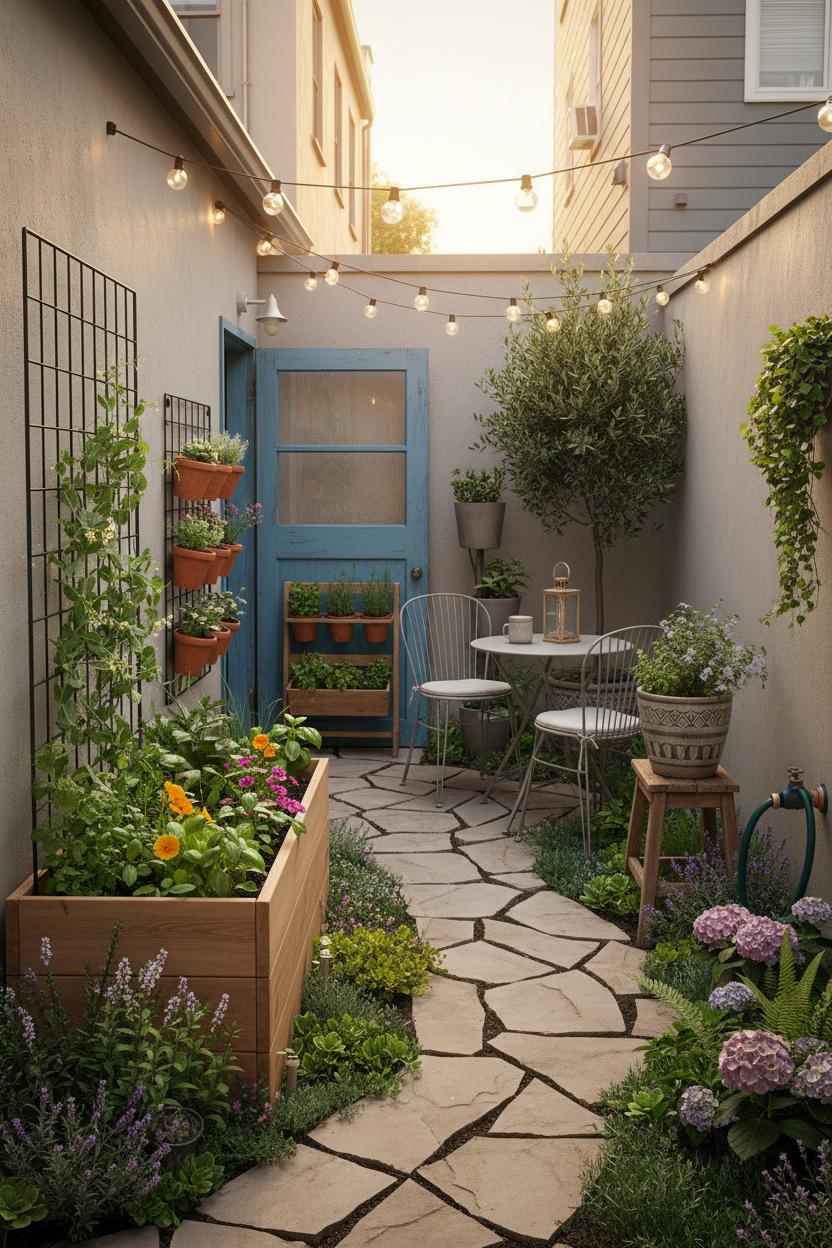
Before you buy a single plant, pull out a tape measure and get cozy with your space. Note where the sun actually lands at 9 a.m., noon, and late afternoon, and sketch the major features—doorways, steps, hose spigots, that pretty view from the kitchen sink. Put utilities and downspouts on the map, too. In a small garden, every inch has a job, so measure widths for comfy paths (think 18–24 inches), and mark the spots you naturally walk so you’re not trampling future herbs. This simple “site study” transforms vague home garden ideas into a clear layout and helps you decide what belongs where.
Next, zone it. Give yourself a grow zone (veggies, herbs, flowers), a gather zone (a chair or bistro set), and a glide zone (pathways), then layer by height to build depth. Tuck a raised garden bed along the sunniest edge to anchor the space and improve soil, and keep the planting width within arm’s reach so maintenance stays easy. If your light shifts through the seasons, lean into container gardening; you can shuffle pots as the sun moves, and self-watering planters keep greens happy on busy weeks. Place an herb garden kit near the back door for quick snips while cooking, and group thirstier plants closest to the hose so watering is a quick loop, not a chore. Curves soften straight lines, but in tight quarters, gentle diagonals can make the footprint feel larger—just a slight tilt of a planter or pathway can create that pleasing “expand” effect.
To truly maximize, think upward. A vertical garden adds square footage you didn’t know you had: install a slim vertical trellis for peas, cucumbers, or jasmine, add wall rails for trailing strawberries, and hang petite pots at staggered heights to draw the eye up. Corners are power spots—stack planters or nestle a dwarf tree to frame the seating area. Tie it all together with a simple palette and a small focal point—a lantern, a rustic stool, or a statement pot—and extend the magic into the evening with outdoor string lights. Whether you’re refreshing a balcony or planning a full backyard makeover, these scaled-to-fit moves turn a small garden into a cozy, lush retreat that feels thoughtfully designed and wonderfully livable.
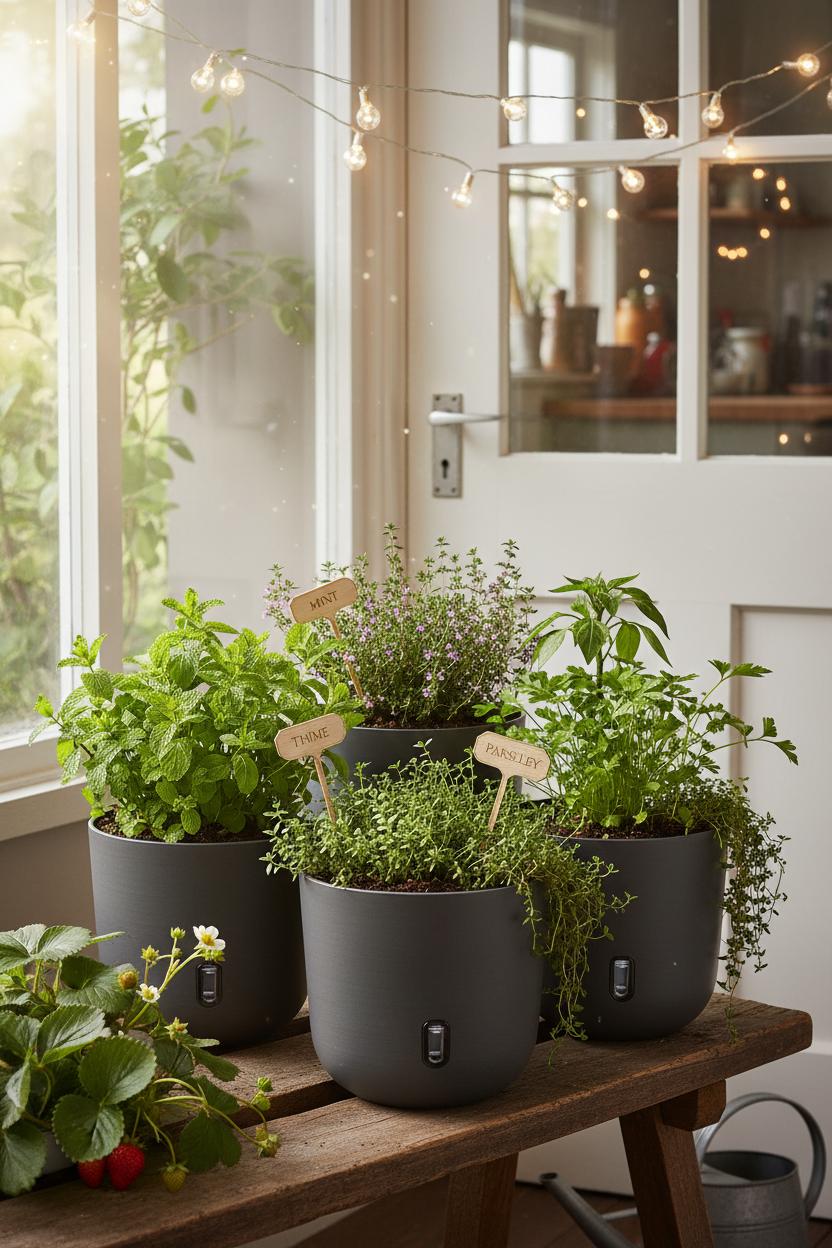
If watering schedules make you nervous, self-watering planters are the small-space superhero you’ve been waiting for. These clever containers have a hidden reservoir and a wicking system that feeds roots from below, so your basil, pothos, or cherry tomatoes sip steadily instead of riding the drought–flood rollercoaster. For anyone exploring home garden ideas in a small garden or on a balcony, this kind of container gardening feels like a gentle exhale: fewer chores, happier plants, and far less guesswork. Picture a cluster of sleek planters by the kitchen door—mint, thyme, and parsley from a simple herb garden kit—staying lush while you sneak away for a long weekend. Even moisture means fewer crispy leaves, reduced blossom-end rot on tomatoes, and less stress overall, which translates to more growth and more green. It also means your morning coffee ritual turns into a mini greenhouse moment, all glossy leaves and soft scents, even if your “yard” is really a sunlit window ledge.
To get the most from self-watering planters, keep things simple and smart. Choose sizes that match your plants’ root systems, use a light potting mix with perlite or coconut coir so water wicks evenly, and start with a little top watering to settle the soil before letting the reservoir take over. If you’re craving height and drama in tight quarters, pair a tall planter with a vertical trellis and let cucumbers or pole beans climb into a mini vertical garden; the tidy reservoir below keeps vines from sulking in midsummer heat. Group three or four planters on a low bench to mimic a petite raised garden bed, then string warm outdoor string lights overhead for an instant, twinkly backyard makeover. Tuck in strawberries to cascade over the rims, add a dwarf pepper for color, and fill any gaps with trailing thyme for that pretty spill effect. These easy upgrades turn a dead corner into a leafy destination, reminding you that container gardening can be both beautifully low-maintenance and richly layered, especially when your planters do the watering for you.
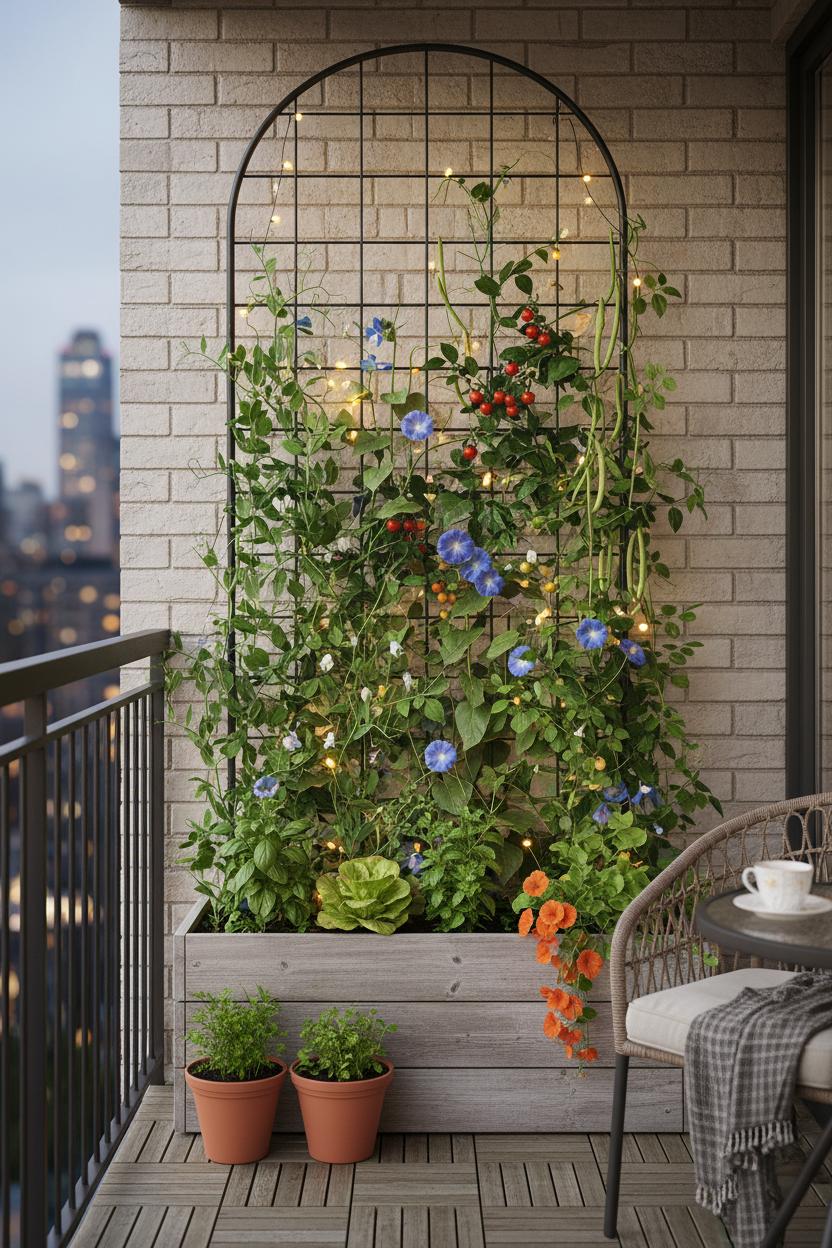
When space is tight, the best trick is to go up, not out—think of your wall or fence as a blank canvas and let a vertical trellis become the frame for a living work of art. A slim trellis tucked behind a raised garden bed or anchored in a large pot instantly multiplies your growing area, letting peas, cucumbers, cherry tomatoes, and pole beans climb skyward while your floor stays clear. This is one of those home garden ideas that feels tailor-made for a small garden or balcony: it layers plants at different heights, creates lush texture without the clutter, and turns container gardening into a statement moment. Add trailing nasturtiums or morning glories for color, or go for fragrance with jasmine and sweet peas—the whole setup reads like a little greenhouse vignette, but make it stylish.
Start with a sturdy vertical trellis that fits your space and light—grid styles are great for veggies, while arched or ladder shapes add a romantic line for flowering vines. Nestle it into a raised garden bed or pair it with self-watering planters to keep moisture consistent and roots happy, especially in sunny spots that dry out fast. Use a high-quality potting mix, plant taller climbers at the back, and tuck compact herbs or lettuce in front; an herb garden kit is perfect for filling pockets and window boxes with basil, mint, and parsley you can snip right at the door. As vines grow, guide them with soft ties and pinch to encourage branching. The beauty of this vertical garden approach is that it’s equally practical and pretty—more airflow around leaves, less pest pressure, and an easy harvest that doesn’t have you bending over every five minutes.
For the finishing touch, weave outdoor string lights through the trellis for a twinkly evening canopy and instant backyard makeover vibes. Even renters can get the look with a freestanding trellis and rolling planters that move with the seasons. The result is a cozy, layered oasis that feels bigger than it is, a little sanctuary where salads climb, herbs perfume the air, and your favorite nook becomes the heart of your home. Among small-space home garden ideas, this one is the quiet hero: minimal footprint, maximum charm.
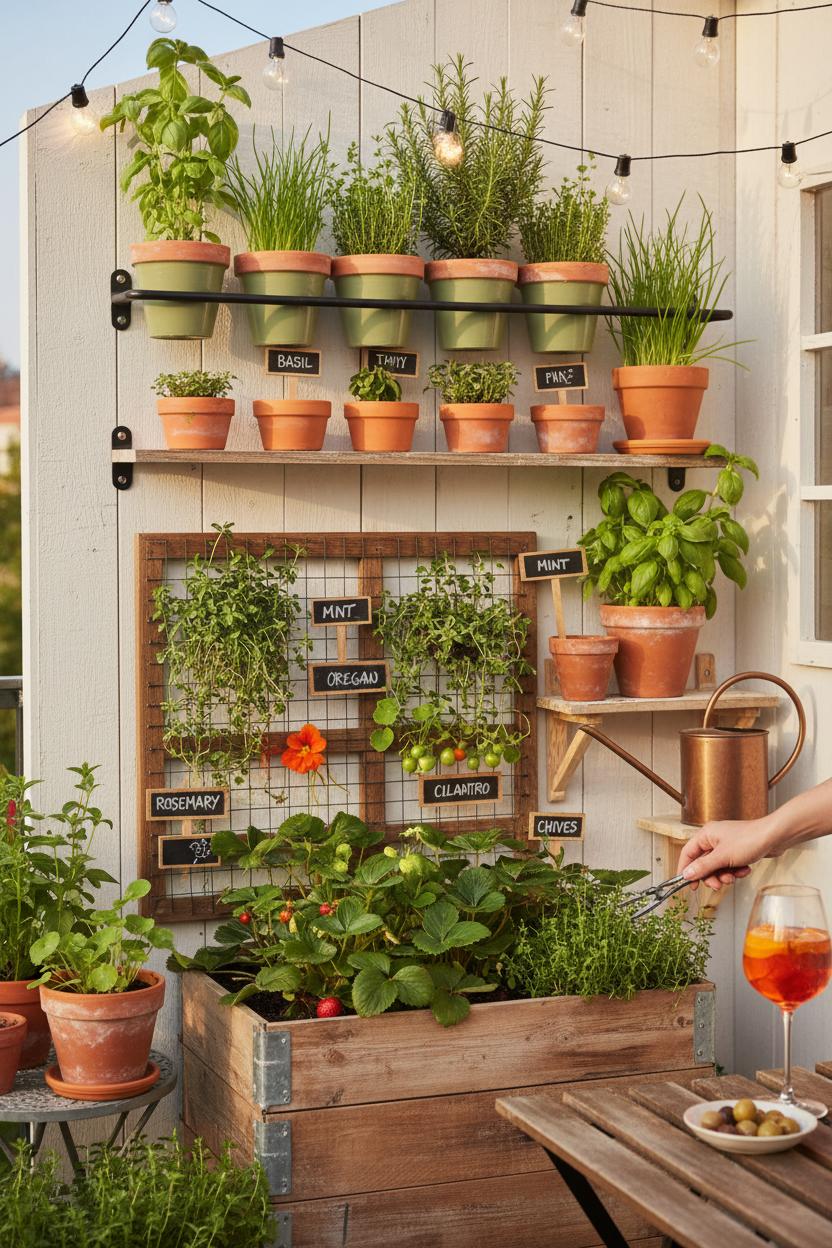
If you’ve ever dreamed of clipping a sprig of basil right into your pasta, start with an herb garden kit and let everyday cooking lead your home garden ideas. Kits make it wonderfully foolproof—most come with seeds, soil pods, and tidy little markers—so you can set up a small garden on a sunny windowsill or balcony in under an hour. Pair the kit with self-watering planters to keep thyme, parsley, and mint hydrated without guesswork, and lean into container gardening so everything stays neat and easy to move as the light shifts. A narrow tray of herbs instantly warms up a countertop, and the fragrance alone feels like a cozy hug—fresh, green, and a little bit dreamy every time you brush by.
In tight quarters, think vertical and layered. Mount a slim rail or wall rack to create a mini vertical garden right by the kitchen door, or hang pots along a balcony railing. A vertical trellis can hold trailing oregano and cascading nasturtiums, while petite shelves keep chives and cilantro at eye level for quick snips. If you have a patio, tuck your kit herbs into a compact raised garden bed along with strawberries or cherry tomatoes for a delicious little backyard makeover moment. Group pots by water needs, cluster taller rosemary in the back, and let low growers spill front and center. The whole arrangement becomes a living centerpiece you’ll actually use every day.
Style it like a tiny greenhouse you can’t wait to visit: mismatched terra-cotta, a splash of sage-green paint on the pots, handwritten labels, and a small watering can that lives on display. Snip often to keep plants lush, sow a second round of basil two weeks after the first for continuous harvests, and rotate containers toward the light so they grow evenly. On summer evenings, drape outdoor string lights above your herb nook and cue the sunset aperitivo; suddenly, the humblest corner becomes a scene. These simple tweaks turn container gardening into a ritual—beautiful, fragrant, and wildly practical—proof that even the smallest space can serve up kitchen-fresh greens on repeat.
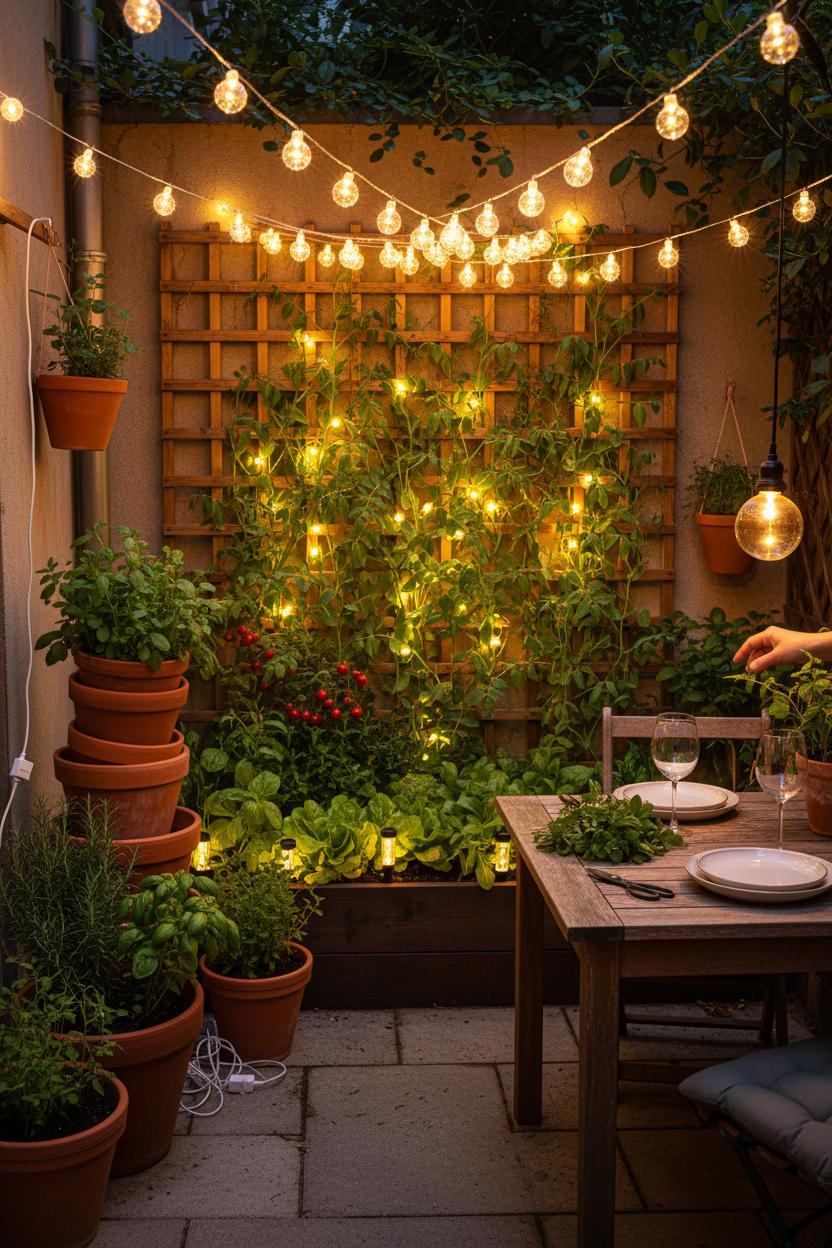
There’s a kind of magic that happens when the sun dips and your tiny balcony or patio begins to twinkle. Drape warm outdoor string lights in a loose zigzag overhead to create a canopy, or weave them along a vertical trellis so your climbers glow like fireflies—instant backyard makeover for even the smallest footprint. On a micro patio, loop shatterproof globes around the railing and let them spill behind a vertical garden to create a soft halo that makes foliage look lusher and shadows deeper. If you’re into container gardening, cluster pots and a raised garden bed under a gentle strand so herbs, tomatoes, and lettuces feel like they’re part of one intimate room. Choose warm-white LEDs (around 2200–2700K) to keep the vibe cozy and to attract fewer insects than cooler light; put them on a timer or dimmer so the space goes softly dark later, giving plants and pollinators the rest they need. Clip rather than tie to avoid damaging vines, and keep bulbs a touch off the leaves to prevent abrasion in the wind.
Beyond ambience, the right glow genuinely supports plant care. A little evening light means you can do relaxed walk-throughs—snip a handful from your herb garden kit, spot-check soil, or catch early pest nibbles—without harsh floodlights. It’s easier to water thoughtfully at dusk or dawn when you can actually see the soil surface; pair that with self-watering planters and your greens stay evenly hydrated, reducing stress and mildew. If you’re collecting home garden ideas for a small garden, think in layers: a curtain of fairy lights behind a vertical garden to add depth, a strand threaded along a vertical trellis to guide peas upward, and a subtle border of stake lights around a raised garden bed to define the edge. Solar options keep cords tidy on balconies, while plug-in strands with weatherproof connectors are great for patios that host dinner-for-two under the vines. However you hang them, outdoor string lights turn practical plant time into a nightly ritual—one where you linger, listen to leaves rustle, and give your garden the extra five minutes that make all the difference.
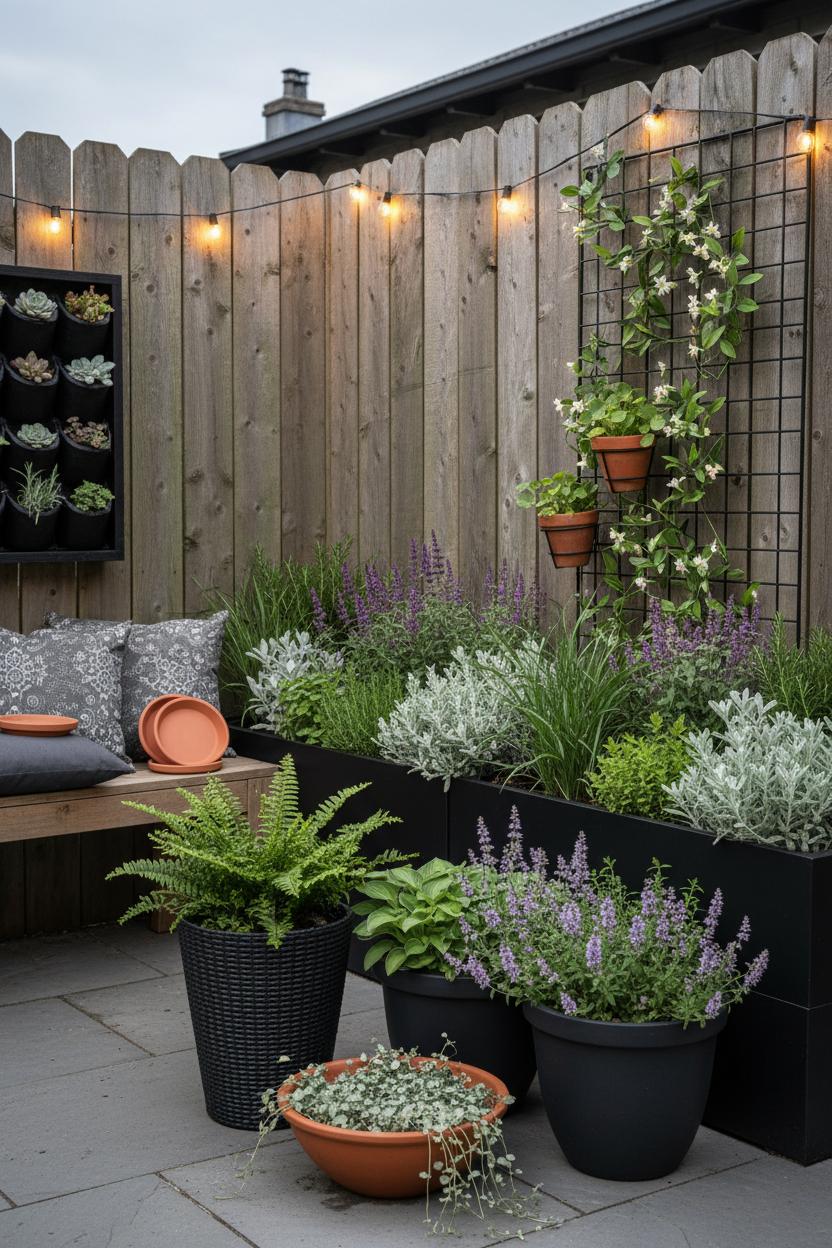
Think of your small garden like a well-styled room: a tight color palette and a few repeating textures make everything feel intentional and lush. Start by choosing two or three container finishes you love—say terracotta, matte black fiberstone, and woven seagrass—and repeat them throughout. That repetition instantly creates style cohesion, even when your plants are wildly different. In container gardening, this consistency is your secret sauce: group pots in odd numbers, echo shapes, and vary heights so each vignette has a tall “thriller,” mid-height “fillers,” and trailing “spillers.” A slim raised garden bed along a fence can act as the anchor, with self-watering planters sprinkled in for low-maintenance pockets of green. Tuck herbs between ornamentals; an herb garden kit can bring matching pots and labels that keep things charming rather than chaotic.
Don’t forget the verticals. A small garden becomes a layered sanctuary when you use the walls and fence lines. Try a vertical trellis in a repeating material—black metal if your pots are black, or warm wood to echo terracotta—and let jasmine, cucumbers, or sweet peas climb, creating a living backdrop. Mix in a simple vertical garden panel or narrow shelves for shallow pots to pull color up and around eye level. Repeat textures with trailing ivy, dichondra, or nasturtiums cascading from window boxes. When space is tight, this up-and-over mindset feels like a mini backyard makeover without heavy construction. At dusk, weave outdoor string lights across the vertical trellis line or along the fence; that warm glow visually stitches each cluster together and makes even a handful of containers feel like a designed room.
Play with a color story that flatters your space and light. Cool-toned palettes—silvery sage foliage, dusty lavender blooms, charcoal containers—read serene and spacious. Prefer cozy and bold? Pair moody greens and burgundy heuchera with terracotta and coppery grasses. Texture is just as important as color: the feathery fronds of ferns, the broad gloss of hosta, and the fine needles of rosemary highlight each other when repeated in small doses. These simple home garden ideas—limited finishes, echoed hues, layered textures, and a bit of vertical drama—turn even the tiniest patio into a lush little retreat. Add a bench cushion, a few matching saucers, and you’ve got cohesion that feels collected, not cluttered.
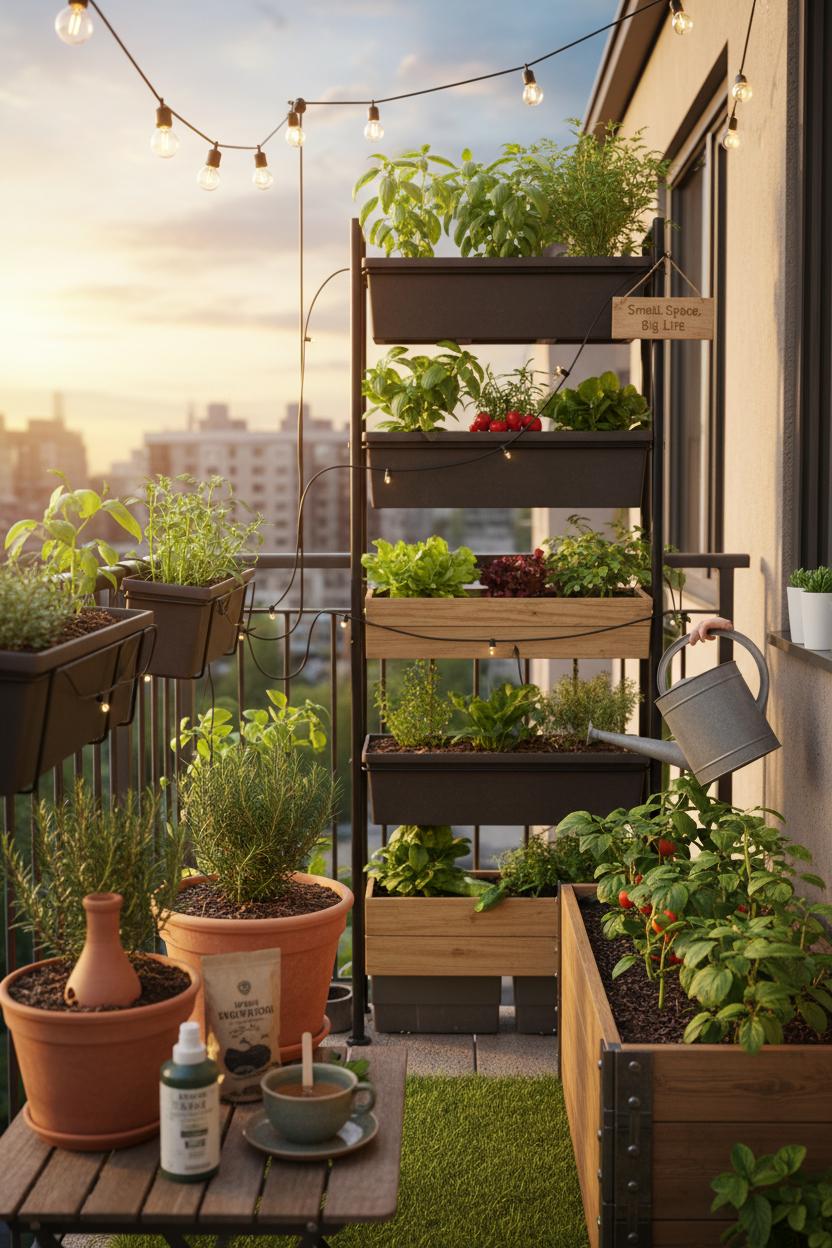
Water is the quiet rhythm behind any lush small garden, and in container gardening that beat is a little faster. Because pots heat up and dry out, think deep and regular rather than quick sips: water in the morning until you see a steady trickle from the drainage holes, then let the soil breathe. Use the “skewer test” (a wooden stick poked into the mix) to check moisture below the surface; if it comes out dry or barely damp, it’s time. Materials matter—terracotta drinks faster than glazed ceramic, and shallow planters dry quicker than tall ones—so group thirstier plants together and tuck shade-lovers behind a taller vertical trellis where they catch dappled light. In a tiered vertical garden, the top levels dry out first; give them an extra pass. If you’re busy or planning a backyard makeover, self-watering planters are a set-it-and-glow-up move, wicking from a reservoir so basil, strawberries, and lettuces stay perky between waterings.
Feeding is the other half of the love story. Containers get leached by frequent watering, so blend a rich, airy potting mix (compost, coco coir, and perlite) and add a slow-release fertilizer at planting. Then micro-dose through the season—half-strength liquid seaweed or fish emulsion every 10–14 days keeps herbs and blooms steady without drama. A sprinkle of worm castings on the surface acts like a gentle vitamin; work it in lightly and water to activate. Once a month, give pots a long, thorough soak to flush any salt buildup. Mulch the top with shredded leaves, straw, or fine bark to hold moisture and keep roots cool; even a thin layer makes a difference on sunny balconies. If you started with an herb garden kit, bump those babies up into roomier homes as they grow so roots don’t dry out in a blink.
For set-it-and-savor care, thread a simple drip line on a timer through your railing boxes, raised garden bed, and vertical planters—tiny emitters at each pot, calm mornings for you. Clay ollas or watering spikes tucked into larger containers deliver moisture right at the roots with zero fuss. At dusk, flick on outdoor string lights, do a quick wander with your watering can, and pinch a sprig of mint for tea. Simple, repeatable rituals like these are the secret sauce behind the prettiest Pinterest-worthy home garden ideas—small space, big life.
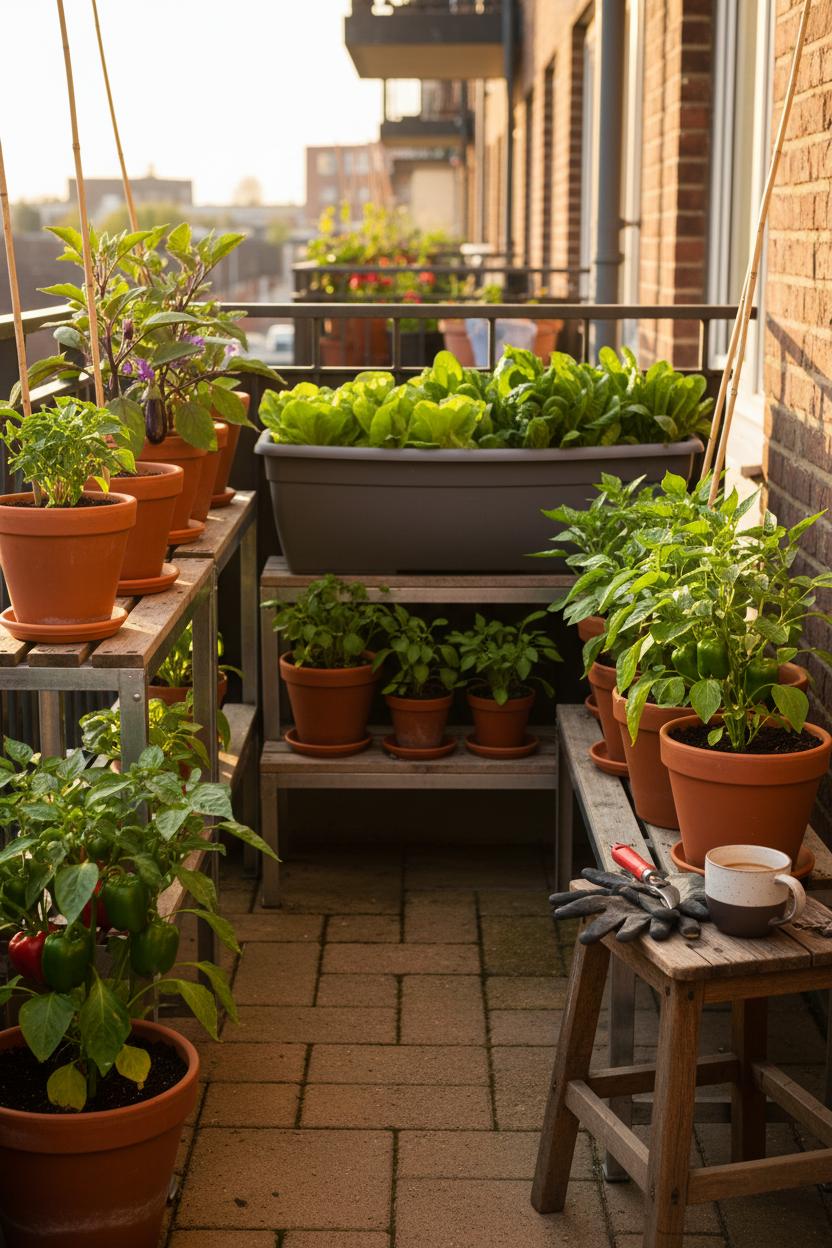
Think of a seasonal refresh as your small garden’s closet clean-out: you’re not starting over, just rotating favorites to the front. In a tight space, container gardening makes this simple—slide sun-lovers like peppers and eggplant into the brightest spot as days lengthen, and tuck leafy greens back into dappled shade when heat arrives. If you’re growing tomatoes in pots, move them to a new container or a raised garden bed each year to break up pests’ routines, then follow with a quick crop like bush beans or calendula. Vining plants can take turns on a vertical trellis—peas in spring, cucumbers in summer, and sweet peas or nasturtiums when it cools—turning one skinny footprint into a season-long vertical garden. These small shifts feel like a mini backyard makeover without the big overhaul.
Pruning is your polish. Every week or two, walk the patio with snips and a coffee, deadheading spent blooms so new buds keep coming, lightly shaping rosemary or lavender to stay tidy, and pinching basil before it flowers to keep flavors bright. Cut back leggy growth on trailing plants and tie wandering vines to their supports for airflow. As you tidy, refresh the soil surface with a scoop of compost, water deeply, and let self-watering planters handle the hot spells. A simple rinse of pots and tools between plant swaps helps avoid lingering disease. If an herb is past its prime, no guilt—replant from an herb garden kit for an instant, fragrant reset on the windowsill or balcony rail.
Replanting is where the mood shifts. Swap cool-season violas and lettuce for zinnias, dwarf dahlias, or peppers; underplant taller crops with thyme or strawberries to fill gaps; and edge a bed with compact marigolds for a sunny ribbon. Add a new vertical trellis to lift a corner and free up floor space for a café table, or nestle a low-profile raised garden bed against a fence for salad greens you can snip daily. As dusk falls, drape outdoor string lights overhead and let the glow turn your refresh into a cozy gathering spot. Among the easiest home garden ideas, these seasonal rotations make a small garden feel endlessly lush, lively, and ready for its close-up.
From window boxes to trellised herbs, these home garden ideas prove any small garden can feel cozy and lush. Mix container gardening on your balcony with a vertical garden by the door, and let color, texture, and fragrance layer your space. Start with a few favorite plants, add thrifted pots, and string lights for instant charm. Whether it’s a balcony nook or a tiny patio, your backyard makeover begins one planter at a time. Pin your plan, sip something warm, and watch your little oasis grow—simple, beautiful, and perfectly you.